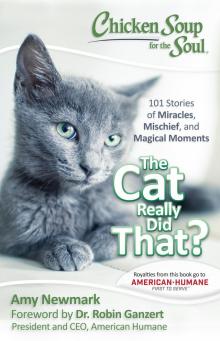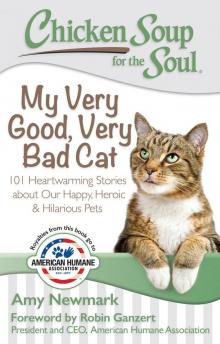- Home
- Amy Newmark
My Very Good, Very Bad Cat Page 4
My Very Good, Very Bad Cat Read online
Page 4
“How did you get in here?”
Then she looked down.
I will never forget the blood-curdling scream from that bathroom. We watched as our mother, covered in bubbles and wearing only a towel, came racing down the stairs yelling for our dad.
“Those cats hate me!” she cried.
The following week, Dad took them to a neighbor’s farm several miles away, where they quickly adapted to their new surroundings as barn cats, playing amongst the horses and hay and tall clover in the back pasture. We visited them often that last summer before we moved. On one of our last visits, the farmer came over to the barn and told us about a strange occurrence that happened a few days prior.
“Those two cats are wrapped in mischief.”
“What do you mean?” Dad asked.
He pointed to Dirty Face.
“That one there ain’t so bad. Just likes to jump out from behind the barn door and scare the dickens out of my wife when she goes to collect eggs from the hens.
“But that one there,” he said, pointing at Fluffy, “is pure devil. We don’t know how in the world she got in the house, but the other morning while we were eating breakfast, she jumped up onto the kitchen table and dropped a live baby copperhead onto my wife’s plate. Can you believe that?”
Our dad tilted his head back and laughed. “Doesn’t surprise me in the least.”
~Cheryll Snow
The Prodigal Cat
Fun fact: Cat food left outdoors may encourage hungry coyotes to eat it (and your cat), too.
Our decade-old gray Tabby, Augie, whose ancestry must have included Attila the Hun and Genghis Kahn, had escaped. It was a crisp Christmas morning and my husband wanted a fire. Augie was snoozing in his secluded corner, fifteen feet from the door, so my husband slipped out for firewood. Coming in, his arms full of wood, he became aware of a quick furry exit.
Augie had recently been in a skirmish that reduced half his face to hamburger. The vet had sent him home with antibiotics and the dreaded head cone, to be worn at least until mid-January. He was not supposed to go outside wearing that thing.
When Augie didn’t show up that night for dinner (despite our calling “Here, kitty kitty, turkey trimmings”), we decided the prodigal would surely return the next day. After all, if The Cone impaired his ability to slurp down his usual canned food, how would he manage with four-legged food that could run away?
Three days later, I was trudging through the snow, leaving “lost cat” notes at every home on the block. A “lost pet” ad with photo went in the paper. But by the end of the week, concluding he was gone for good, I washed his sleeping pad and dishes.
Our life with Augie had begun one blistering August afternoon. While I sweated in the kitchen preparing dinner, my husband and son left in search of shade. They ended up at a local riverside park legendary for unauthorized animal disposal. Unwanted bunnies and kittens and native groundhogs roamed its thick landscaping shrubs. Coyotes in the adjacent hill considered the park their private restaurant.
Enter tender-hearted husband and son, who heard a weak meow from a drainage culvert. The tiny one, who couldn’t resist a chicken nugget plucked from the trash, found himself wrapped in an old towel and headed for a new future.
“He will be an outdoor cat,” my husband assured me, rummaging in the cupboard for some tuna. My asthma had limited pets to those swimming in a fish bowl. Augie, so named for being found in August, would break the household furry-pet ban.
The “outdoor cat only” promise was forgotten as winter came. I vacuumed twice as much and went to the doctor for stronger asthma medicine. When Aug became the Handsome Hunk for local fertile female felines, I shuffled him off to the vet for The Operation. Of course, the bill got padded: “Animal Control laws require a rabies shot.” And that led to a notice from Animal Control that he needed a pet license to dangle off his flea collar.
Life with Augie soon settled into a rhythm of cat food and catting around. Not wanting to install a pet door (the neighborhood had raccoons), we resigned ourselves to increased use of the back door for his “duty” and “recreation,” the latter requiring at least annual trips to the vet for his relapses into warfare.
Despite doting human care, some cats have no moral conscience for taking care of their keepers in old age. And thus, our prodigal felt compelled to escape that Christmas morning, liberating him to revel in the riotous living curtailed by his convalescence.
Three weeks later, I was fixing dinner one frigid January night when my husband came in after teaching school, holding a familiar gray-striped animal. “He was sitting in the garage when I raised the door,” he said. The Prodigal had returned — skinnier, filthy, and still wearing the dreaded head cone. We peeled it off, retrieved his food dish and opened a remaining can of cat food. Augie ate seconds and thirds. When picked up, he pushed his head into the crook of an elbow, unwilling to look at us. If cats could talk, he might have said, “I have sinned against thee. I am no longer worthy to be called your pet cat. Please accord me a corner of the garage for duties in catching mice.” His repentance speech included a recital of extra-loud purring. For a week, he refused to leave the house.
That was three years ago. His Christmas adventure didn’t cure him of the occasional need for vet trips and recovery cones. But never again has he taken such an extended vacation from his human family. Life is too good when you don’t have to worry where your next meal is coming from. Especially when Christmas might mean some turkey trimmings.
~Jeanne Zornes
Never Name a Cat After Dylan Thomas
Fun fact: Ancient sailors thought it brought on trouble to say a cat’s name, even though cats were welcomed on board to keep rodents under control.
My first mistake was probably in naming him after Dylan Thomas. My orange cat, named after the poet who had authored “Do Not Go Gentle into That Dark Night,” took the message of that poem just a little too seriously. As my friend so perfectly put it: “That cat isn’t going anywhere gently.”
To be fair, I couldn’t have known what was coming. When I first met Dylan, he was cowering in the back of a cage at the local animal shelter. His name at the time was Armand. A friend had seen his ad in the paper and, knowing that I was looking for a cat and was partial to orange kitties, had suggested I go see him. He wasn’t exactly what I was looking for — I’d wanted a young kitten, preferably a female. Dylan was almost two years old, male, and afraid of everything. His ad had stated that he would need some “time to warm up” in his new home.
Meeting him at the shelter, though, I was warned that he would need quite a bit of time to be left alone to explore his new home on his own terms. His previous owners had abandoned him, simply putting him outside in December in New England and then moving away. A neighbor had seen him and kept him on his porch for a week before bringing him to the shelter.
There wasn’t an open room for me to visit with him at the shelter, and this grand orange cat curled himself into the far corner of his cage, watching me. From another cage, a calico threw herself against the bars, trying to get me to pat her. She purred relentlessly, walking back and forth against my hand and her cage door so much that she built up static electricity and began to shock herself. Still, she purred and reached her paws out, literally grabbing for my attention. Dylan curled himself away from me and went to sleep.
I brought Dylan home. It took the shelter employees an unsettling amount of time to get him into the cat carrier, and by the time they brought him out to me, I was a bundle of nervous energy, wondering if I was making the right move. Dylan yowled for the first ten minutes of the drive, but then pressed himself in the back of the carrier and remained silent.
Once we were home, I let him out, and he quickly investigated my Netherland Dwarf rabbit. I got my first good look at Dylan as he raced for the safety of my bed; I hadn’t been able to fully see into the cage at the shelter. He was impressively big and had beautiful orange stripes down his legs. The tip of his tail was
white. Once he disappeared under my bed, I assumed I wouldn’t see him for days, as I’d been warned.
That night, I woke up to Dylan climbing on me as I lay in bed. I didn’t touch him or even dare to move; I just let him explore my bed in the safety of the darkness. I was elated that he was feeling confident enough to venture out already.
And that was when the adventure started. Not only was Dylan confident enough to roam throughout my apartment, he assumed that everything in it was his.
Within a few days, he had shredded entire rolls of toilet paper while I slept. He punctured a tube of toothpaste and a bottle of spray-in hair conditioner with his teeth. He carried a plush dog, larger than his head, throughout the apartment, frequently bringing it up to my bed. He stole rolls of paper towels and decorated the kitchen in confetti. In less than thirty seconds, he chewed a hole in a brand-new bag of cat litter. He stole a tray of a dozen cupcakes that I had purchased from the store and chewed through the bottoms. He chewed off the corners of my unopened mail, tore pages out of my notebooks, and dog-eared (or should it be cat-eared?) the corners of too many paperbacks. He climbed up onto the back of the toilet tank, picked up the full box of tissues with his mouth, and dragged it into the living room where he proceeded to pull out the tissues and shred them. (He’s done this multiple times, along with his toilet-paper and paper-towel tricks.)
In one of his more stellar stunts, Dylan bit into a glass Christmas tree light before carrying it around the apartment in his mouth. His vet almost didn’t believe me when I called after that incident.
And that’s not to say that he was neglected — far from it. I began investing in every type of cat toy on the market. Dylan had piles of toys that he loved — he just thought my things were more fun.
In less than six months, my exasperated status updates on Facebook prompted a friend to suggest that maybe Dylan was lonely. I had to admit that she was probably right. Dylan came dashing into the room any time I played a YouTube video with cats in it; he would search for the cats, talking to them all the while.
And so, questioning my sanity, I went back to the shelter and adopted another cat, a young female calico. Dylan was determined they would be instant friends, though the female, whom I named Cara didn’t agree at first.
In time, Cara came around, and Dylan had his buddy. His destructive behavior stopped almost immediately, though I still have to guard my toilet paper and paper towels. Now I’m lucky to watch these two play games of tag throughout my apartment. Having two cats wasn’t in my plan, but I’m learning that life often takes turns that you never see coming. Now these two are my buddies, and I wouldn’t trade them for the world.
Dylan still has a few tricks up his sleeve — he opens my kitchen cabinets every night, and carries the rubber stopper from the bathroom sink throughout the house. He recently ate half a paper towel that he got out of the covered trash, prompting an unusual call to the vet. But for the most part, he’s settled, content to play with Cara. I still keep the toilet paper stored up high, though — with him, you just never know.
~Paige Cerulli
My Boy, George
Fun fact: Adult cats have thirty teeth. Kittens have twenty-six baby teeth, which they lose when they’re about six months old.
Brush my cat’s teeth? I’d do better poking hot needles into my eyes. We’d just returned from a health-and-wellness checkup, and the veterinarian said my cat had tartar and redness along the gum line. She recommended a dental-food diet and encouraged me to brush his teeth. The items on my kitchen counter seemed innocent enough — salmon-flavored paste and a nubby rubber thimble.
The vet’s advice was correct, but I knew my cat. Taking out extra life insurance seemed like a really good plan before venturing forth. Don’t get me wrong, I love my boy, and I’d do anything for him, but this seemed like a recipe for disaster.
* * *
It was Mother’s Day, and cats were on sale at the Humane Society. George had been found outdoors by a concerned cat lover who’d kept him a few days before turning him in. The sign on the cage said, “Approximately one year old. George doesn’t like to be picked up.” That should have been my first clue.
He prowled and howled, scratching at the door as if to say, “Get me out of here.” There was nothing about his attitude that said, “Please take me home. I’ll be a nice little kitty.”
I knew George was different, but then again so was I. This cat strummed my heartstrings like a well-tuned banjo. Huge, staring green eyes and the most gorgeous face you could imagine. It didn’t matter that he was a black cat. I didn’t believe the superstition.
After I answered a million questions to prove I would be a responsible owner, I was handed George in a cardboard box. Fortunately, I’d brought a friend and cat lover with me. Tammy was a foster mom for the SPCA when she worked in Texas, and was an expert when it came to cats. Thank God, she was with me.
On the expressway, George burst out of the cardboard box and found his way under the clutch. Shifting gears was out of the question. With the car in neutral in the centre lane, cars passed and honked on both sides. I would have raised my middle finger at them, my own brand of instant messaging, but my hands had a death grip on the steering wheel.
My friend managed to get George into the back seat, and I was relieved to get the little black bundle home. We showed him his litter box, he did some scratching, and then proceeded to explore. For the most part, he seemed docile. George had a new home!
The honeymoon was soon over. Three days after his adoption, I had a call from Public Health indicating he’d bitten the person who rescued him. A representative would follow up. Yikes, my cat had a criminal record!
By then, I knew George was prone to scratching and biting. His demeanor in the cage was manifesting itself. He’d sometimes follow me down the hallway and nip at the back of my legs. I presumed it was all about power and control and adjusting to his new surroundings. As a registered nurse, I’d worked in psychiatry for ten out of the last forty years. I understood behavior and took the time to look at cause and effect. I could forgive his actions. When the investigator from Public Health arrived, she said, “I’m not really a cat lover.” It was a brief visit, and fortunately George refrained from biting her.
* * *
George continued to be a bit of a nasty boy. Never a lap cat, he only wanted affection when it suited him. I understood and respected his wishes. He’d still nip and sometimes let me know when enough was enough. A cat just acts the way it feels!
The second year I had him, he escaped through my daughter’s bedroom window, two floors up in a condo. She’d taken the panels out to clean them, not thinking he’d see it as an escape route. She was in tears, and so was I.
My heart was broken, and that’s when I realized how attached I’d become to him, even though he mostly behaved badly. I posted pictures and notices on all the local signposts, knocked on neighbors’ doors, searched relentlessly, prowled the neighborhood late at night and walked around shaking a treat bag. I didn’t care if I looked like an idiot. I just wanted him back.
After seventy-two hours, I was devastated. It was time for one final look around. At 11:00 p.m., I ran into my neighbor walking her dog. By then, I was resigned to the fact that George was gone. The neighbor gave me a hug, and I walked across the street to my condo entrance. As I approached the front door, a little black devil rushed toward me from under the shrubs. I’d like to think he jumped into my arms, but that’s not his style. He did, however, allow me to pick him up and take him inside. There was only a slight “nip” in the elevator. I presumed it meant he was happy to see me.
* * *
George is now seven years old and a tad more complacent. It took three years for him to lie beside me on the couch for a whole fifteen minutes, and another two years before I could actually pick him up for three minutes without him biting me. This was progress.
But that whole brushing the cat’s teeth thing had me stymied. I knew the vet was right, but I al
so understood my cat. Just getting George into a cage to visit the vet was a challenge. Usually, it involved a bit of hissing, retrieval from under the bed and a chase down the hallway.
At the vet’s, he always makes a liar out of me. “He’s not necessarily a friendly cat,” I say, but when they open the carrier door, out pops a docile black cat. He explores the counter and waits patiently for shots. They open his mouth, check his teeth and gums, and even trim his nails, with no bloodshed.
George and I have a peaceful co-existence and I love him dearly, but that toothbrush and paste seemed akin to raising a red flag in front of a bull. I looked at him and shook my head.
I left the sample toothbrush and paste in the community laundry room. It was safer there, and so was I.
His favorite diversion at the moment is a long piece of thick red string. He plays with it, takes it in his mouth and bites down while I pull it through. At my next veterinarian’s visit, I will assure her I’m flossing my cat’s teeth. That’s almost like brushing, isn’t it?
~Connie Cook
Reprinted by permission of www.offthemark.com
What Are We Going to Do About Watson?
Not-so-fun fact: “Kitten season,” when animal shelters usually have an overabundance of kittens, occurs in the late summer and early fall.
Is there truly such a thing as a bad cat? Yes, I think so. His name is Watson. And I think his mother might even agree.
I know thousands of cats on a very personal level — as personal as you can get, a cat might tell you. Sticking my fingers in their ears and their mouths and sometimes other places they won’t admit, I try to remember I am trespassing on the feline’s sense of dignity each time I examine a cat within the four walls of my veterinary exam room. But even there, where some lash out in fear, some climb the walls, and others will not be trespassed upon, I cannot say I’ve met a bad cat. Until Watson.

 Chicken Soup for the Soul
Chicken Soup for the Soul The Joy of Less
The Joy of Less Hope & Miracles
Hope & Miracles The Cat Really Did That?: 101 Stories of Miracles, Mischief and Magical Moments
The Cat Really Did That?: 101 Stories of Miracles, Mischief and Magical Moments The Joy of Christmas
The Joy of Christmas My Very Good, Very Bad Dog
My Very Good, Very Bad Dog My Very Good, Very Bad Cat
My Very Good, Very Bad Cat